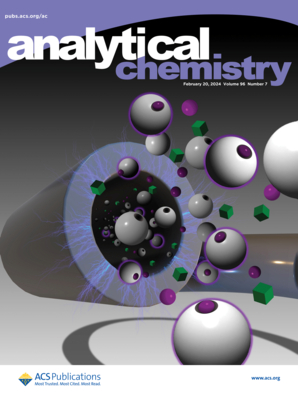Unveiling Lipid Droplet Dynamics in Parkinson's Disease via a Polarity-Responsive Alkenyl Indole-Based Fluorophore.
IF 6.7
1区 化学
Q1 CHEMISTRY, ANALYTICAL
引用次数: 0
Abstract
Lipid droplets (LDs) are dynamic organelles implicated in Parkinson's disease (PD) pathology, yet their polarity dynamics and therapeutic relevance remain poorly understood. Herein, we rationally designed a polarity-responsive alkenyl indole-based fluorophore, PD3, through systematic molecular engineering to enable real-time tracking of LD polarity in PD models. By modulating intramolecular charge transfer (ICT) effects via electron-donating/withdrawing substitutions, PD3 exhibited exceptional polarity sensitivity, with a dramatic fluorescence enhancement in low-polarity environments and negligible viscosity interference. Density functional theory calculations confirmed that the polarity response originated from ICT-driven solvatochromism and solvent-dependent internal conversion rates. In rotenone-induced PD cellular models, PD3 revealed significant LD accumulation (4.2-fold intensity increase, 74% higher LD density, and 46% enlarged diameter) and organelle crosstalk, particularly with the endoplasmic reticulum (ER) and mitochondria. Furthermore, PD3-enabled evaluation of PD drugs demonstrated that amantadine (AMA) and pramipexole (PPX) restored LD homeostasis, linking their therapeutic effects to LD modulation. Ex vivo studies in methyl-phenyl-tetrahydropyridine (MPTP)-induced PD mice confirmed LD accumulation in brain tissues, correlating with motor deficits and neuronal loss in the substantia nigra. This work establishes PD3 as a powerful tool for deciphering LD-associated PD pathology and advancing LD-targeted therapeutic strategies.通过极性响应的烯基吲哚基荧光团揭示帕金森病脂滴动力学。
脂滴(ld)是与帕金森病(PD)病理相关的动态细胞器,但它们的极性动力学和治疗相关性仍然知之甚少。本文通过系统的分子工程,合理设计了极性响应的烯基吲哚基荧光团PD3,实现了PD模型中LD极性的实时跟踪。通过给电子/吸电子取代来调节分子内电荷转移(ICT)效应,PD3表现出了优异的极性敏感性,在低极性环境下具有显著的荧光增强,粘度干扰可以忽略不计。密度泛函理论计算证实极性响应源于ict驱动的溶剂致变色和依赖溶剂的内部转化率。在鱼藤酮诱导的PD细胞模型中,PD3显示出显著的LD积累(强度增加4.2倍,LD密度增加74%,直径增大46%)和细胞器串扰,特别是与内质网(ER)和线粒体的串扰。此外,PD药物的pd3激活评估表明,金刚烷胺(AMA)和普拉克索(PPX)恢复LD稳态,将其治疗效果与LD调节联系起来。对甲基苯基四氢吡啶(MPTP)诱导的PD小鼠的体外研究证实,LD在脑组织中积累,与运动缺陷和黑质神经元丢失有关。这项工作确立了PD3作为破译ld相关PD病理和推进ld靶向治疗策略的有力工具。
本文章由计算机程序翻译,如有差异,请以英文原文为准。
求助全文
约1分钟内获得全文
求助全文
来源期刊

Analytical Chemistry
化学-分析化学
CiteScore
12.10
自引率
12.20%
发文量
1949
审稿时长
1.4 months
期刊介绍:
Analytical Chemistry, a peer-reviewed research journal, focuses on disseminating new and original knowledge across all branches of analytical chemistry. Fundamental articles may explore general principles of chemical measurement science and need not directly address existing or potential analytical methodology. They can be entirely theoretical or report experimental results. Contributions may cover various phases of analytical operations, including sampling, bioanalysis, electrochemistry, mass spectrometry, microscale and nanoscale systems, environmental analysis, separations, spectroscopy, chemical reactions and selectivity, instrumentation, imaging, surface analysis, and data processing. Papers discussing known analytical methods should present a significant, original application of the method, a notable improvement, or results on an important analyte.
 求助内容:
求助内容: 应助结果提醒方式:
应助结果提醒方式:


